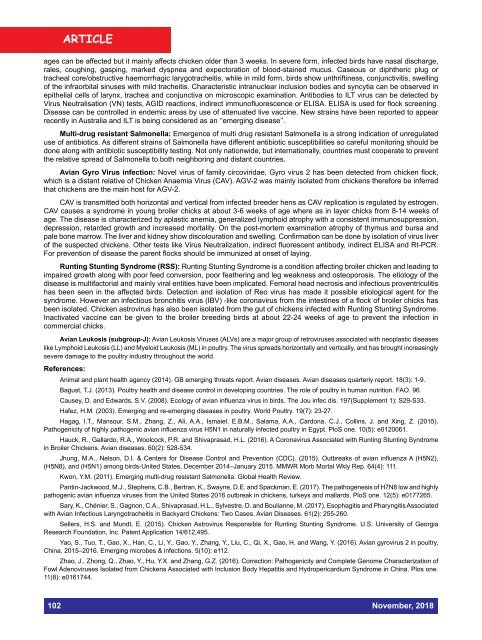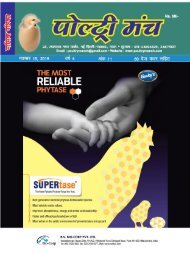November 2018 Punch PDF
You also want an ePaper? Increase the reach of your titles
YUMPU automatically turns print PDFs into web optimized ePapers that Google loves.
ARTICLE<br />
ages can be affected but it mainly affects chicken older than 3 weeks. In severe form, infected birds have nasal discharge,<br />
rales, coughing, gasping, marked dyspnea and expectoration of blood-stained mucus. Caseous or diphtheric plug or<br />
tracheal core/obstructive haemorrhagic larygotracheitis, while in mild form, birds show unthriftiness, conjunctivitis, swelling<br />
of the infraorbital sinuses with mild tracheitis. Characteristic intranuclear inclusion bodies and syncytia can be observed in<br />
epithelial cells of larynx, trachea and conjunctiva on microscopic examination. Antibodies to ILT virus can be detected by<br />
Virus Neutralisation (VN) tests, AGID reactions, indirect immunofluorescence or ELISA. ELISA is used for flock screening.<br />
Disease can be controlled in endemic areas by use of attenuated live vaccine. New strains have been reported to appear<br />
recently in Australia and ILT is being considered as an ‘‘emerging disease’’.<br />
Multi-drug resistant Salmonella: Emergence of multi drug resistant Salmonella is a strong indication of unregulated<br />
use of antibiotics. As different strains of Salmonella have different antibiotic susceptibilities so careful monitoring should be<br />
done along with antibiotic susceptibility testing. Not only nationwide, but internationally, countries must cooperate to prevent<br />
the relative spread of Salmonella to both neighboring and distant countries.<br />
Avian Gyro Virus infection: Novel virus of family circoviridae, Gyro virus 2 has been detected from chicken flock,<br />
which is a distant relative of Chicken Anaemia Virus (CAV). AGV-2 was mainly isolated from chickens therefore be inferred<br />
that chickens are the main host for AGV-2.<br />
CAV is transmitted both horizontal and vertical from infected breeder hens as CAV replication is regulated by estrogen.<br />
CAV causes a syndrome in young broiler chicks at about 3-6 weeks of age where as in layer chicks from 8-14 weeks of<br />
age. The disease is characterized by aplastic anemia, generalized lymphoid atrophy with a consistent immunosuppression,<br />
depression, retarded growth and increased mortality. On the post-mortem examination atrophy of thymus and bursa and<br />
pale bone marrow. The liver and kidney show discolouration and swelling. Confirmation can be done by isolation of virus liver<br />
of the suspected chickens. Other tests like Virus Neutralization, indirect fluorescent antibody, indirect ELISA and Rt-PCR.<br />
For prevention of disease the parent flocks should be immunized at onset of laying.<br />
Runting Stunting Syndrome (RSS): Runting Stunting Syndrome is a condition affecting broiler chicken and leading to<br />
impaired growth along with poor feed conversion, poor feathering and leg weakness and osteoporosis. The etiology of the<br />
disease is multifactorial and mainly viral entities have been implicated. Femoral head necrosis and infectious proventriculitis<br />
has been seen in the affected birds. Detection and isolation of Reo virus has made it possible etiological agent for the<br />
syndrome. However an infectious bronchitis virus (IBV) -like coronavirus from the intestines of a flock of broiler chicks has<br />
been isolated. Chicken astrovirus has also been isolated from the gut of chickens infected with Runting Stunting Syndrome.<br />
Inactivated vaccine can be given to the broiler breeding birds at about 22-24 weeks of age to prevent the infection in<br />
commercial chicks.<br />
Avian Leukosis (subgroup-J): Avian Leukosis Viruses (ALVs) are a major group of retroviruses associated with neoplastic diseases<br />
like Lymphoid Leukosis (LL) and Myeloid Leukosis (ML) in poultry. The virus spreads horizontally and vertically, and has brought increasingly<br />
severe damage to the poultry industry throughout the world.<br />
References:<br />
Animal and plant health agency (2014). GB emerging threats report. Avian diseases. Avian diseases quarterly report. 18(3): 1-9.<br />
Bagust, T.J. (2013). Poultry health and disease control in developing countries. The role of poultry in human nutrition. FAO. 96.<br />
Causey, D. and Edwards, S.V. (2008). Ecology of avian influenza virus in birds. The Jou infec dis. 197(Supplement 1): S29-S33.<br />
Hafez, H.M. (2003). Emerging and re-emerging diseases in poultry. World Poultry. 19(7): 23-27.<br />
Hagag, I.T., Mansour, S.M., Zhang, Z., Ali, A.A., Ismaiel, E.B.M., Salama, A.A., Cardona, C.J., Collins, J. and Xing, Z. (2015).<br />
Pathogenicity of highly pathogenic avian influenza virus H5N1 in naturally infected poultry in Egypt. PloS one. 10(5): e0120061.<br />
Hauck, R., Gallardo, R.A., Woolcock, P.R. and Shivaprasad, H.L. (2016). A Coronavirus Associated with Runting Stunting Syndrome<br />
in Broiler Chickens. Avian diseases. 60(2): 528-534.<br />
Jhung, M.A., Nelson, D.I. & Centers for Disease Control and Prevention (CDC). (2015). Outbreaks of avian influenza A (H5N2),<br />
(H5N8), and (H5N1) among birds-United States, December 2014–January 2015. MMWR Morb Mortal Wkly Rep. 64(4): 111.<br />
Kwon, Y.M. (2011). Emerging multi-drug resistant Salmonella. Global Health Review.<br />
Pantin-Jackwood, M.J., Stephens, C.B., Bertran, K., Swayne, D.E. and Spackman, E. (2017). The pathogenesis of H7N8 low and highly<br />
pathogenic avian influenza viruses from the United States 2016 outbreak in chickens, turkeys and mallards. PloS one. 12(5): e0177265.<br />
Sary, K., Chénier, S., Gagnon, C.A., Shivaprasad, H.L., Sylvestre, D. and Boulianne, M. (2017). Esophagitis and Pharyngitis Associated<br />
with Avian Infectious Laryngotracheitis in Backyard Chickens: Two Cases. Avian Diseases. 61(2): 255-260.<br />
Sellers, H.S. and Mundt, E. (2015). Chicken Astrovirus Responsible for Runting Stunting Syndrome. U.S. University of Georgia<br />
Research Foundation, Inc. Patent Application 14/612,495.<br />
Yao, S., Tuo, T., Gao, X., Han, C., Li, Y., Gao, Y., Zhang, Y., Liu, C., Qi, X., Gao, H. and Wang, Y. (2016). Avian gyrovirus 2 in poultry,<br />
China, 2015–2016. Emerging microbes & infections. 5(10): e112.<br />
Zhao, J., Zhong, Q., Zhao, Y., Hu, Y.X. and Zhang, G.Z. (2016). Correction: Pathogenicity and Complete Genome Characterization of<br />
Fowl Adenoviruses Isolated from Chickens Associated with Inclusion Body Hepatitis and Hydropericardium Syndrome in China. Plos one.<br />
11(8): e0161744.<br />
102 <strong>November</strong>, <strong>2018</strong>





